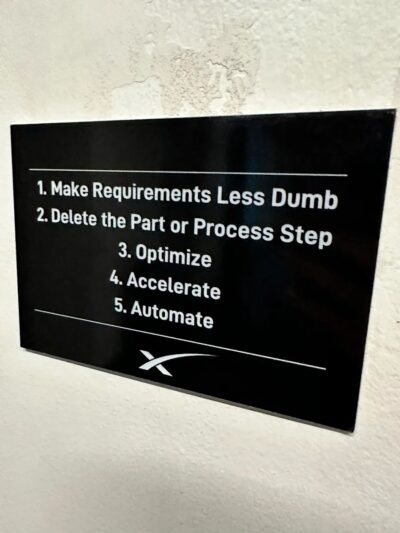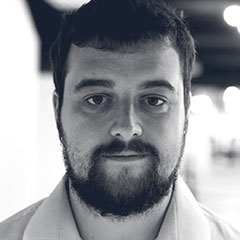The Space Exploration Technologies Corporation – SpaceX – is known to us all as Elon Musk’s company with the stated goal of enabling the colonisation of Mars. SpaceX was born on the Long Island Expressway in 2000. Musk had been forced out as CEO of PayPal. The question came up: what was Musk going to do next? He’d always been interested in space, and checked out NASA’s website, looking for plans for humans going to Mars. He didn’t find any. So, Musk came up with his own.
In early 2001, Musk donated $100k to the Mars Society. He gave a plenary talk at their fourth convention where he announced Mars Oasis, a project to land a greenhouse and grow plants on Mars. Unable to get cooperation from either US or Russian space agencies, Musk announced he would start a company to build the affordable rockets they needed.
Since 2002, the development of Falcon 9, Falcon Heavy rockets, and Starlink satellites are evidence of Musk’s ambition to decrease the cost and improve the reliability of access to space, ultimately by a factor of ten. The company is also developing Starship, a reusable, super heavy lift launch system for inter planetary and orbital spaceflight. It is intended to become SpaceX’s primary orbital vehicle, supplanting the existing Falcon 9, Falcon Heavy, and Dragon fleet.
Some two weeks ago, Starship’s first orbital flight test ended in a mid-air explosion over the Gulf of Mexico. The flight lasted just four minutes. After launch, multiple engines in the booster progressively failed, causing the vehicle to reach ‘max Q’ – the point at which the stress on the vehicle caused by thrust of the engines and the resistance of the atmosphere peaks – later than planned.
By minute three of the launch, it was clear that something was wrong. The rest of the engines had not cut off at the appointed time; the rocket was changing its orientation strangely; the separation of the second stage, was not progressing as intended. As video showed the rocket continuing to tumble, John Insprucker, a SpaceX engineer providing commentary for the company’s live feed, delivered a technical understatement for the ages: obviously…this does not appear to be a normal situation.
Eventually, the vehicle lost control and spun erratically, eventually activating the automated flight termination system, which intentionally destroyed the rocket. The good news is that SpaceX says it is building Super Heavies and Starships at a healthy clip; it should in principle be possible to rerun the test reasonably soon once the nature of the problem becomes clear and a fix is found.
The company accentuated the positive: the rocket made it into the air and through max Q, both things it had not done before. The point of flight testing is to find problems in processes which cannot be tested on the ground. In that sense the test was a success, and if that is a slightly rosy view, it is at heart a fair one. For the flight to have gone off entirely as planned would have been a truly phenomenal coup.
SpaceX is the first private company to develop a liquid-propellant rocket that has reached orbit; to launch, orbit, and recover a spacecraft; to send a spacecraft and astronauts to the International Space Station. SpaceX’s Falcon 9 rockets have landed and reflown more than 150 times. Through Musk’s searing ambition it showcases the focus needed to literally, get a startup off the ground. Here are ten key lessons from Space X to apply to any startup product strategy – five ‘big thinking’ principles, and five ‘good practice habits’, here’s my take.
Big thinking principles
1. Don’t start with a product, start with a problem SpaceX didn’t start off building its own rockets. Musk travelled to Russia to try to buy a refurbished intercontinental ballistic missile. The problem was the Russians had no respect for Musk so they offered him their rockets at a ridiculous markup. I wondered what it would take to build our own rocket, said Musk. A few years later, SpaceX had done just that.
2. Do your research Musk needed to prove he was serious. He had degrees in economics and physics and applied that mentality to his new area of focus. He read everything he could get his hands on about rockets, from old Soviet technical manuals to John Drury Clark’s iconic book on propellants, Ignition! Further, Musk knew that other entrepreneurs had dabbled in rocket science and failed, so he studied what they had done, learning from their mistakes to avoid repeating them.
3. Embrace challenges Musk’s original plan was to inspire the public, leading to more funding for NASA. But the more Musk learned, the more he realised NASA had its own problems beyond funding. I looked at the horses that NASA had in the stable. And with horses like Boeing and Lockheed, you’re screwed. Those horses are lame. I knew Mars Oasis would not be enough. Musk began to think bigger.
If SpaceX could cut through the red tape that plagued NASA, it could help pave the way to pursue those opportunities. Not everyone was as enthusiastic. Musk called a meeting of twenty prominent aerospace engineers who were encouraged to attend by Mike Griffin, who would later become the administrator of NASA.
Musk announces he wants to start his own rocket company. There was a lot of chuckling, some laughter, people saying things like Save your money, kid, and go sit on the beach. But Musk wouldn’t give up easily. Musk searched among the doubters to find the few believers, people who embraced a challenge rather than shrank from it, optimists rather than pessimists. It didn’t take long, and Musk found those optimists.
4. Pursue ambitious goals and think long-term Musk is renowned for setting ambitious goals and thinking long-term. His endeavours all revolve around solving significant problems for humanity. As a product manager, it’s important to think beyond short-term gains and focus on creating products that have a lasting, positive impact on users, create products that truly matter.
5. Foster a culture of innovation and calculated risk-taking Musk is known for his daring – some would say reckless – attitudes at times, but his approach to product development is driven by fostering a culture that encourages experimentation, collaboration, and calculated risk-taking.
In a startup, it’s essential to create an environment where your team feels empowered to explore new ideas, challenge existing thinking, and take risks in pursuit of ground-breaking solutions to drive product success and stay ahead of the competition.
Good practice habits
6. Make the requirements less dumb. Musk notes that your requirements are definitely dumb, it does not matter who gave them to you. His approach is to ‘question the question’, to test assumptions, pointing out that requirements from a ‘smart person’ are often the most dangerous since you might not question them enough. Seek absolute clarity and justification on why a feature is needed.
7. Delete as part of the build process If you’re not adding things back in at least 10% of the time, you’re not deleting enough. Musk suggests starting lean and building up when and if required but warns that the bias will be to add things in case – but you can make ‘in case’ arguments for so many things. He goes further, arguing that each requirement or constraint must be accountable to a person, because you can ask that person about its relevance and purpose.
8. Simplify or optimise the design Possibly the most common error of a smart engineer is to optimise a thing that should not exist. Musk emphasises the importance of working through the first two steps before trying to optimise. To do this effectively, he believes that each engineer needs to take a holistic view of the project.
9. Accelerate cycle time – but wait to automate Musk embraces the drive to go faster but warns against pointing your efforts in the wrong direction, saying if you’re digging your grave, don’t dig faster. He advocates an accelerated agile approach, but only after the first three steps of his process are satisfied to ensure that you’re moving faster in the right direction.
10. Embrace interdisciplinary thinking Musk’s approach to product design is characterised by merging knowledge from different disciplines, combining engineering, design, business, and even psychology. As a product manager, fostering interdisciplinary thinking allows you to approach problems from various angles and uncover innovative solutions.
The spectacular explosion of SpaceX’s Starship rocket minutes after it soared off its launch pad on a first flight test is a vivid illustration of a ‘successful failure’ business formula that serves all startups well. Rather than seeing the fiery disintegration as a setback, the dramatic loss of the rocket will accelerate development based on lessons learned. Much better this testing unearths the problems now, rather than when in commercial deployment.
SpaceX test once they believe that they have a 51% chance of success. Musk terms this the ‘escape velocity’, an interesting mindset, which means it take the least amount of capital in a broad definition that will get them valid results. This more rapid testing leads to more rapid development.
It means SpaceX saves time and money in the long run and takes less time to identify and correct engineering flaws by taking more risks in the development process rather than keeping a large team working trying to get it perfect before it’s in the hands of paying customers. The risks of a single flight test were small in comparison to the ambitious gains at stake.
The ’build, measure, learn’ agile ethos at a juncture when cash, quality and time are key determinants in business growth and survival offers startups a way to deliver the right product at the right time and in the most time and cost-effective way possible. Aligned with Musk’s five ‘big thinking’ and five ‘good habits’ it is a strong methodology.
In an interview with TED, engineer and employee number seven at SpaceX, Gwynne Shotwell, talked about how they managed to get billion-dollar deals from NASA, despite the fact that the first three SpaceX rockets blew up. How can you sell something you don’t have? If your prototype isn’t working the way you hoped it would, and you need something to show to your stakeholders, focus on what you can show to them. There’s always something you can showcase, whether it’s your vision, the skill of your team, and the answers you’ve found so far. All startups have a story to sell and that should be part of your product development strategy too.
Whether you believe that we’ll walk on Mars or not, you’d be hard-pressed to find a more ambitious goal. We’ve been stargazing since Babylon, but SpaceX is a new venture in terms of humanity’s obsession with the cosmos, and it can feel like everything they’re doing is happening very suddenly and is therefore unrealistic.
But If you showed the latest iPhone to Jobs in 1976 when he and Wozniak were selling the first Apple computer, or any recent Triple-A game to William Higginbotham when he invented Pong in 1970, what would they say? Seemingly impossible things don’t stay that way forever.
But it is not easy, you have to be brave and bold to make testing and subsequent failure a core part of your startup product development strategy and philosophy. SpaceX’s previous record in innovation is a remarkable one. There are many obstacles ahead for them, but it is not too hard to imagine them achieving their goals. Why can’t it be the same for your audacious startup product thinking?


